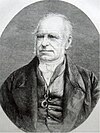United Kingdom general election, 1826
|
|
||||||||||||||||||||||
|---|---|---|---|---|---|---|---|---|---|---|---|---|---|---|---|---|---|---|---|---|---|---|
|
||||||||||||||||||||||
|
|
||||||||||||||||||||||
|
All 658 seats to the House of Commons 330 seats needed for a majority |
||||||||||||||||||||||
|
||||||||||||||||||||||
|
||||||||||||||||||||||
The 1826 United Kingdom general election saw the Tories under the Earl of Liverpool win a substantial and increased majority over the Whigs. In Ireland, Home Rule candidates, working with the Whigs, won large gains from Unionist candidates.
The seventh United Kingdom Parliament was dissolved on 2 June 1826. The new Parliament was summoned to meet on 25 July 1826, for a maximum seven-year term from that date. The maximum term could be and normally was curtailed, by the monarch dissolving the Parliament, before its term expired.
The Tory leader was the Earl of Liverpool, who had been Prime Minister since his predecessor's assassination in 1812. Liverpool had led his party to three general election victories before that of 1826.
The Tory Leader of the House of Commons until 1822, when he committed suicide, was Robert Stewart. He was known by the courtesy title of Viscount Castlereagh, until he inherited his father's Irish peerage and became the 2nd Marquess of Londonderry in 1821. Londonderry was replaced as leader by George Canning, who remained Leader of the House of Commons in 1826.
The Whig Party continued to suffer from weak leadership, particularly in the House of Commons.
In 1824 the Earl Grey gave up the formal Whig leadership in the Lords, although he remained the most prominent Whig peer. Grey asked his friends to look to the leadership of the Marquess of Lansdowne. Although Lansdowne performed the functions of leader, he did not accept the title.
...
Wikipedia


